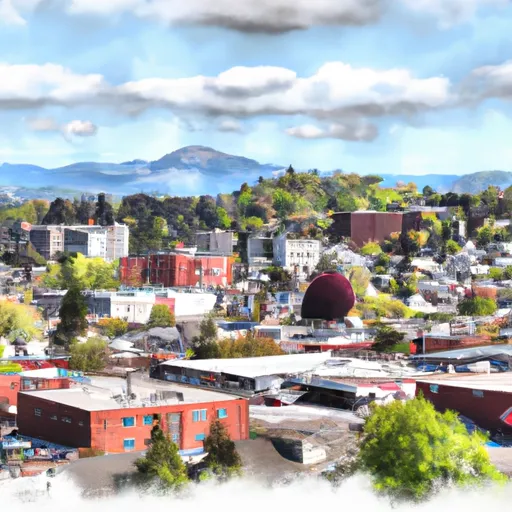-
 Snoflo Premium
Snoflo Premium
Get unlimited access to all our content
With no Ad interruptions! - Start Your Free Trial Login with existing account
Shelton
Eden Index
Climate
6.9
•
Recreation
3.4
•
Community
1.9
•
Safeguard
4.4/10

Shelton, Washington, is a picturesque city located in Mason County. The climate of Shelton is characterized by mild summers and cool, wet winters. The average high temperatures during summer range from 70°F to 80°F, while winter temperatures average around 40°F. Precipitation is evenly distributed throughout the year, with an annual average of around 60 inches, making Shelton a lush and green destination for outdoor enthusiasts.
One of Shelton's highlights is its hydrology constituents, with numerous lakes and rivers dotting the region. The city is situated on the western shore of Oakland Bay and is surrounded by the Shelton Creek and Goldsborough Creek watersheds. These water bodies offer opportunities for fishing, boating, kayaking, and wildlife observation.
Outdoor recreation in Shelton is abundant, with the city bordering the Olympic National Forest and being close to the Olympic National Park. This proximity provides ample opportunities for hiking, camping, and exploring the natural beauty of the Pacific Northwest. The nearby Hood Canal offers opportunities for water sports such as swimming and diving. Additionally, Shelton is known for its golf courses, parks, and trails, attracting visitors year-round.
In summary, Shelton, Washington, boasts a mild climate, abundant hydrology constituents, and diverse outdoor recreation opportunities, making it an ideal destination for nature enthusiasts and outdoor adventurers.
What is the Eden Index?
The Snoflo Eden Index serves as a comprehensive rating system for regions, evaluating their desirability through a holistic assessment of climate health, outdoor recreation opportunities, and natural disaster risk, acknowledging the profound impact of these factors on livability and well-being.
Climate Health Indicator (CHI): 6.9
Shelton receives approximately
1692mm of rain per year,
with humidity levels near 88%
and air temperatures averaging around
11°C.
Shelton has a plant hardyness factor of
8, meaning
plants and agriculture in this region tend to thrive here all year round.
By considering the ideal temperature range, reliable water supplies, clean air, and stable seasonal rain or snowpacks, the Climate Health Indicator (CHI) underscores the significance of a healthy climate as the foundation for quality living.
A healthy climate is paramount for ensuring a high quality of life and livability in a region, fostering both physical well-being and environmental harmony. This can be characterized by ideal temperatures, reliable access to water supplies, clean air, and consistent seasonal rain or snowpacks.
Weather Forecast
Streamflow Conditions
Puget Sound
Area Rivers
Puget Sound
Snowpack Depths
Puget Sound
Reservoir Storage Capacity
Puget Sound
Groundwater Levels
Recreational Opportunity Index (ROI): 3.4
The Recreational Opportunity Index (ROI) recognizes the value of outdoor recreational options, such as parks, hiking trails, camping sites, and fishing spots, while acknowledging that climate plays a pivotal role in ensuring the comfort and consistency of these experiences.
Access to outdoor recreational opportunities, encompassing activities such as parks, hiking, camping, and fishing, is crucial for overall well-being, and the climate plays a pivotal role in enabling and enhancing these experiences, ensuring that individuals can engage in nature-based activities comfortably and consistently.
Camping Areas
| Campground | Campsites | Reservations | Toilets | Showers | Elevation |
|---|---|---|---|---|---|
| Potlatch State Park | 73 | 88 ft | |||
| Camp Cushman | 82 | 753 ft | |||
| Lena Creek | 13 | 821 ft | |||
| Oxbow Rustic | 20 | 525 ft | |||
| Twanoh State Park | 47 | 46 ft | |||
| North Creek- State Forest | 5 | 309 ft | |||
| Millersylvania State Park | 168 | 219 ft | |||
| Brown Creek | 22 | 563 ft | |||
| Hamma Hamma | 15 | 556 ft | |||
| Porter Creek- State Forest | 16 | 294 ft |
Nearby Ski Areas
Catastrophe Safeguard Index (CSI):
The Catastrophe Safeguard Index (CSI) recognizes that natural disaster risk, encompassing floods, fires, hurricanes, and tornadoes, can drastically affect safety and the overall appeal of an area.
The level of natural disaster risk in a region significantly affects safety and the overall livability, with climate change amplifying these risks by potentially increasing the frequency and intensity of events like floods, fires, hurricanes, and tornadoes, thereby posing substantial challenges to community resilience and well-being.
Community Resilience Indicator (CRI): 1.9
The Community Resilience Indicator (CRI) recognizes that education, healthcare, and socioeconomics are crucial to the well-being of a region. The CRI acknowledges the profound impact of these elements on residents' overall quality of life. By evaluating educational resources, healthcare accessibility, and economic inclusivity, the index captures the essential aspects that contribute to a thriving community, fostering resident satisfaction, equity, and social cohesion.

